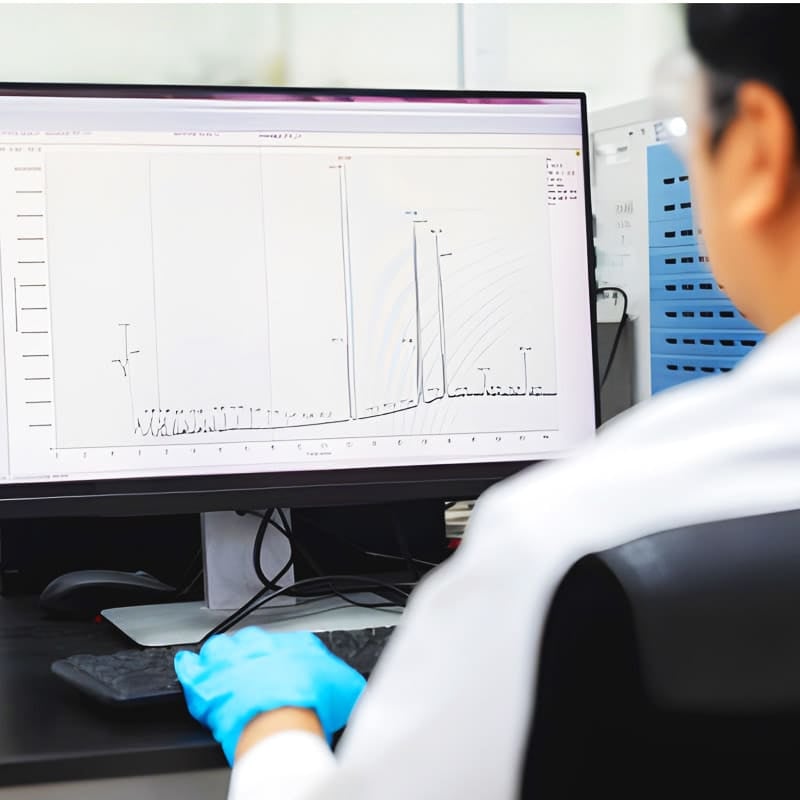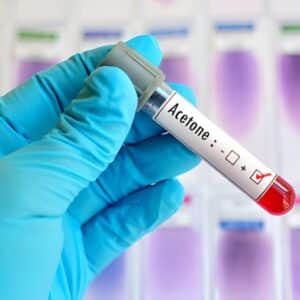82 Allergen Detection Test (GC-MS/MS)
€950.00
Reliable Allergen Testing for Cosmetics, Fragrance, and Home Products
Fragrance allergens are at the heart of EU cosmetic and chemical regulations. Whether they occur naturally in essential oils or are part of synthetic fragrance blends, their presence needs to be measured and declared with precision. Our laboratory offers advanced detection of 82 regulated fragrance allergens using GC-MS/MS technology. This service ensures you stay compliant with EU Cosmetic Regulation 1223/2009, CLP, and IFRA Standards, while also protecting consumer safety and brand reputation.
Why Allergen Testing Matters
Across Europe, companies must declare allergens on cosmetic and detergent labels when concentrations exceed regulatory thresholds. For cosmetics, this means anything above 0.001% in leave-on products or 0.01% in rinse-off products must be listed.
In the past, only 26 allergens needed disclosure, but the list has now expanded to 82 substances. This change affects everyone in the supply chain — from raw material suppliers to brands and safety assessors — and makes reliable allergen testing more important than ever.
What We Test
The method covers the full spectrum of regulated fragrance allergens, including familiar compounds such as Linalool, Citral, Geraniol, Eugenol, Limonene, Coumarin, Benzyl Benzoate, and Farnesol. These substances are often naturally present in essential oils but also appear in synthetic blends. Because their levels vary by source and batch, testing is the only way to ensure accurate disclosure.
✔ A complete list of all 82 allergens is available upon request.
Technology We Use: GC-MS/MS
Our laboratory relies on Gas Chromatography with Tandem Mass Spectrometry (GC-MS/MS), the gold standard for fragrance allergen detection. This method separates complex fragrance mixtures into their individual components and identifies them with high precision.
What makes GC-MS/MS the preferred choice:
-
Detects allergens at very low concentrations (ppm and ppb range).
-
Provides quantitative results rather than simple “present/absent” findings.
-
Works equally well for raw materials and finished products.
In short, GC-MS/MS allows us to deliver data you can rely on for compliance and formulation decisions.
Applications of the 82 Allergen Test
Our allergen detection service is designed for a wide range of industries. Cosmetic brands use it to prepare their CPSR and product labels. Candle and diffuser makers depend on it for IFRA compliance and safe consumer labelling. Raw material suppliers benefit from verified data when selling essential oils and fragrance blends.
Other relevant applications include:
-
Cosmetics: perfumes, lotions, hair care, skincare, makeup.
-
Candles and home fragrance: ensuring safe allergen disclosures.
-
Detergents and cleaning products: meeting CLP and Detergent Regulation standards.
Benefits for Your Business
Accurate allergen testing offers more than just compliance. It provides independent verification of supplier documentation, ensures your product information is trustworthy, and supports smooth approval by safety assessors.
Key advantages include:
-
Verified compliance with EU allergen disclosure rules.
-
Essential data for Cosmetic Product Safety Reports (CPSR).
-
Support for creating IFRA Conformity Certificates.
-
Transparent allergen declarations that build consumer confidence.
How the Process Works
Submitting a sample is simple. Send us a sealed quantity of 10–20 g or ml (depending on the product), and we’ll handle the rest. The sample is analysed by GC-MS/MS, and you receive a detailed report with quantified results for all 82 allergens. Reports are delivered as PDF or Excel files, ready to use for regulatory documentation.
-
Turnaround time: 7–10 working days (express analysis available).
-
Reporting: clear concentration values for every allergen.
-
Use case: directly applicable to CPSR, IFRA, PCN, and CLP compliance.
Who Should Use This Test
This service is essential for:
-
Cosmetic brands launching products in the EU/EEA.
-
Fragrance oil suppliers validating natural or synthetic blends.
-
Candle and diffuser makers needing allergen sheets and IFRA compliance.
-
Safety assessors and toxicologists who require verified analytical data.
Why Testing Makes a Difference
Consider lavender essential oil. It naturally contains compounds such as linalool and linalyl acetate, but concentrations vary significantly depending on harvest and origin. Without testing, it’s impossible to know whether the allergen levels exceed regulatory thresholds.
Synthetic fragrance blends can be even more complex, often containing multiple allergens in varying proportions. GC-MS/MS testing ensures these details are measured and reported accurately, protecting both compliance and consumer safety.
Beyond Testing
We also provide follow-up services to help you act on the results:
-
Preparation of IFRA Certificates.
-
Creation of allergen declaration sheets in multiple EU languages.
-
Toxicological pre-screening for formulations.
-
Full compliance packages including CPSR, PCN, UFI, and CLP support.
82 Fragrance Allergens (EU, Annex III)
Here’s the full list of the 82 fragrance allergens that are included in the new expanded EU Cosmetic Regulation Annex III.
| # | INCI Name | CAS Number | Typical Source | Regulatory Status* |
|---|---|---|---|---|
| 1 | Alpha-Isomethyl Ionone | 127-51-5 | Synthetic violet-like fragrance | Restricted allergen |
| 2 | Amyl Cinnamal | 122-40-7 | Jasmine, synthetic | Restricted allergen |
| 3 | Amylcinnamyl Alcohol | 101-85-9 | Jasmine, synthetic | Restricted allergen |
| 4 | Anisyl Alcohol | 105-13-5 | Anise oil, synthetic | Restricted allergen |
| 5 | Benzyl Alcohol | 100-51-6 | Balsams, jasmine | Restricted allergen |
| 6 | Benzyl Benzoate | 120-51-4 | Balsams, essential oils | Restricted allergen |
| 7 | Benzyl Cinnamate | 103-41-3 | Balsam of Peru | Restricted allergen |
| 8 | Benzyl Salicylate | 118-58-1 | Ylang-ylang, synthetic | Restricted allergen |
| 9 | Cinnamal | 104-55-2 | Cinnamon oil | Restricted allergen |
| 10 | Cinnamyl Alcohol | 104-54-1 | Cinnamon leaves | Restricted allergen |
| 11 | Citral | 5392-40-5 | Lemongrass, citrus oils | Restricted allergen |
| 12 | Citronellol | 106-22-9 | Rose, geranium | Restricted allergen |
| 13 | Coumarin | 91-64-5 | Tonka beans | Restricted allergen |
| 14 | Eugenol | 97-53-0 | Clove oil | Restricted allergen |
| 15 | Farnesol | 4602-84-0 | Rose oil, orange blossom | Restricted allergen |
| 16 | Geraniol | 106-24-1 | Rose, palmarosa, citronella | Restricted allergen |
| 17 | Hexyl Cinnamal | 101-86-0 | Jasmine-like scent | Restricted allergen |
| 18 | Hydroxycitronellal | 107-75-5 | Lily of the valley, synthetic | Restricted allergen |
| 19 | Hydroxyisohexyl 3-Cyclohexene Carboxaldehyde (Lyral) | 31906-04-4 | Synthetic | Banned (still monitored) |
| 20 | Isoeugenol | 97-54-1 | Ylang-ylang, clove | Restricted allergen |
| 21 | Limonene | 5989-27-5 | Citrus peel oils | Restricted allergen |
| 22 | Linalool | 78-70-6 | Lavender, coriander | Restricted allergen |
| 23 | Methyl 2-Octynoate (Methyl Heptine Carbonate) | 111-12-6 | Synthetic, fruity-green | Restricted allergen |
| 24 | Evernia Prunastri Extract (Oak Moss) | 90028-68-5 | Lichen extract | Restricted allergen |
| 25 | Evernia Furfuracea Extract (Tree Moss) | 90028-67-4 | Lichen extract | Restricted allergen |
| 26 | 2-(4-tert-Butylbenzyl)propionaldehyde (Lilial) | 80-54-6 | Synthetic floral | Banned (still monitored) |
| 27 | Allyl Heptanoate | 142-19-8 | Pineapple-like, synthetic | Restricted allergen |
| 28 | Allyl Hexanoate | 123-68-2 | Pineapple, synthetic | Restricted allergen |
| 29 | Allyl Phenoxyacetate | 7493-74-5 | Sweet floral, synthetic | Restricted allergen |
| 30 | Allyl 3-Cyclohexylpropionate | 2705-87-5 | Fruity, synthetic | Restricted allergen |
| 31 | Anethole | 4180-23-8 | Anise, fennel | Restricted allergen |
| 32 | Benzaldehyde | 100-52-7 | Almonds, cinnamon oil | Restricted allergen |
| 33 | Benzyl Acetate | 140-11-4 | Jasmine, ylang-ylang | Restricted allergen |
| 34 | Benzyl Formate | 104-57-4 | Fruity, balsamic | Restricted allergen |
| 35 | Benzyl Isoeugenol | 120-11-6 | Synthetic | Restricted allergen |
| 36 | beta-Caryophyllene | 87-44-5 | Clove, copaiba, cannabis | Restricted allergen |
| 37 | Musk T (Bicyclononalactone) | 116-66-5 | Synthetic musk | Restricted allergen |
| 38 | Butylphenyl Methylpropional (Lilial duplicate) | 80-54-6 | Synthetic | Banned |
| 39 | Camphor | 76-22-2 | Camphor tree oil | Restricted allergen |
| 40 | Cananga Oil | 68606-83-7 | Ylang-ylang type | Restricted allergen |
| 41 | Carvone | 2244-16-8 | Caraway, spearmint | Restricted allergen |
| 42 | Cedrol | 77-53-2 | Cedarwood oils | Restricted allergen |
| 43 | Cinnamyl Anthranilate | 87-29-6 | Synthetic | Restricted allergen |
| 44 | Cis-3-Hexenyl Salicylate | 65405-77-8 | Green, leafy scent | Restricted allergen |
| 45 | Citronellyl Acetate | 150-84-5 | Geranium, citronella | Restricted allergen |
| 46 | Citronellyl Nitrile | 51566-62-2 | Synthetic | Restricted allergen |
| 47 | Cyclamen Aldehyde | 103-95-7 | Synthetic floral | Restricted allergen |
| 48 | Dihydroisojasmone | 17283-81-7 | Jasmine-like, synthetic | Restricted allergen |
| 49 | Dimethyl Anthranilate | 85-91-6 | Synthetic, fruity | Restricted allergen |
| 50 | Ethyl Vanillin | 121-32-4 | Vanilla-like, synthetic | Restricted allergen |
| 51 | Eugenyl Acetate | 93-28-7 | Clove, cinnamon leaf | Restricted allergen |
| 52 | Florhydral (3-(4-tert-Butylphenyl)-2-methylpropanal) | 80-54-6 | Synthetic | Restricted allergen |
| 53 | Geranyl Acetate | 105-87-3 | Rose, citronella | Restricted allergen |
| 54 | Helional (3-(4-Methylphenyl)propanal) | 1205-17-0 | Synthetic | Restricted allergen |
| 55 | Hexyl Salicylate | 6259-76-3 | Synthetic floral | Restricted allergen |
| 56 | Indole | 120-72-9 | Jasmine, orange blossom | Restricted allergen |
| 57 | Isoamyl Salicylate | 87-20-7 | Jasmine-like, synthetic | Restricted allergen |
| 58 | Isobutylphenyl Propional | 125-68-8 | Synthetic | Restricted allergen |
| 59 | Isopulegol | 89-79-2 | Mint oils | Restricted allergen |
| 60 | Linalyl Acetate | 115-95-7 | Lavender, bergamot | Restricted allergen |
| 61 | Methyl 2-Nonynoate | 111-80-8 | Synthetic, fruity-green | Restricted allergen |
| 62 | Methyl Chavicol (Estragole) | 140-67-0 | Basil, tarragon | Restricted allergen |
| 63 | Methyl Eugenol | 93-15-2 | Basil, ylang-ylang | Restricted allergen |
| 64 | Methyl Iso-Eugenol | 93-16-3 | Synthetic | Restricted allergen |
| 65 | Methyl Salicylate | 119-36-8 | Wintergreen oil | Restricted allergen |
| 66 | Methyl-N-methyl Anthranilate | 85-91-6 | Synthetic | Restricted allergen |
| 67 | Nerol | 106-25-2 | Rose, lemongrass | Restricted allergen |
| 68 | Ocimene | 13877-91-3 | Citrus, mint oils | Restricted allergen |
| 69 | p-Mentha-1,4-dien-7-ol | 499-75-2 | Mint oils | Restricted allergen |
| 70 | p-Mentha-1,4-dien-7-yl Acetate | 67674-46-8 | Synthetic | Restricted allergen |
| 71 | Phenyl Acetaldehyde | 122-78-1 | Hyacinth, rose | Restricted allergen |
| 72 | Phenylacetic Acid | 103-82-2 | Honey, cocoa | Restricted allergen |
| 73 | Phenylacetonitrile | 140-29-4 | Synthetic | Restricted allergen |
| 74 | Phenylpropyl Alcohol | 122-97-4 | Synthetic floral | Restricted allergen |
| 75 | Precyclemone B | 68155-66-8 | Synthetic musk | Restricted allergen |
| 76 | Rose Ketones (Ionones, Damascones, Damascenones) | Various | Rose oil, synthetic | Restricted allergen |
| 77 | Sclareolide | 564-20-5 | Clary sage | Restricted allergen |
| 78 | Terpineol | 8000-41-7 | Pine, petitgrain | Restricted allergen |
| 79 | Terpinyl Acetate | 8007-35-0 | Pine oils | Restricted allergen |
| 80 | Tetrahydro Linalool | 18479-58-8 | Synthetic | Restricted allergen |
| 81 | Tetrahydro Myrcenol | 18479-57-7 | Synthetic | Restricted allergen |
| 82 | Vanillin | 121-33-5 | Vanilla pods, synthetic | Restricted allergen |
* Regulatory Status: “Restricted allergen” = must be declared above thresholds (0.001% leave-on / 0.01% rinse-off). “Banned” = no longer permitted but still included in analytical screening.




